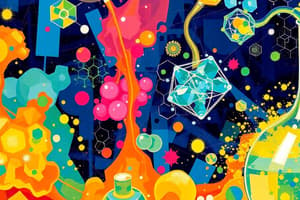Podcast
Questions and Answers
What was done to the precipitate after it was collected by filtration?
What was done to the precipitate after it was collected by filtration?
- It was left untouched
- It was washed with hot water
- It was mixed with solvents
- It was washed with chilled distilled water (correct)
What was the purpose of washing the precipitate with chilled distilled water?
What was the purpose of washing the precipitate with chilled distilled water?
- To mix the precipitate with solvents
- To remove impurities from the precipitate (correct)
- To recrystallize the precipitate
- To dry the precipitate
What was done to the dried precipitate?
What was done to the dried precipitate?
- It was recrystallized from solvents (correct)
- It was mixed with solvents
- It was washed with chilled distilled water
- It was left untouched
What was the percentage of ethanol used for recrystallization?
What was the percentage of ethanol used for recrystallization?
What was the purpose of recrystallization?
What was the purpose of recrystallization?
What is the molecular weight of the given compound?
What is the molecular weight of the given compound?
What is the percentage of Carbon in the given compound?
What is the percentage of Carbon in the given compound?
How many protons are responsible for the signal at 0.59 and 0.68 ppm in the 1H NMR?
How many protons are responsible for the signal at 0.59 and 0.68 ppm in the 1H NMR?
What is the structural feature of the compound responsible for the signal at 7.88 and 8.08 ppm in the 1H NMR?
What is the structural feature of the compound responsible for the signal at 7.88 and 8.08 ppm in the 1H NMR?
What is the molecular formula of the given compound?
What is the molecular formula of the given compound?
In which year was the study 'Pract Res Clin Gastroenterol' published?
In which year was the study 'Pract Res Clin Gastroenterol' published?
What is the page range of the study 'Best Biostructures'?
What is the page range of the study 'Best Biostructures'?
Who are the authors of the study 'Cikla P, Ozcavci D, Sener A and Turan S'?
Who are the authors of the study 'Cikla P, Ozcavci D, Sener A and Turan S'?
In which volume of the journal is the study 'Pract Res Clin Gastroenterol' published?
In which volume of the journal is the study 'Pract Res Clin Gastroenterol' published?
What is the issue number of the study 'Best Biostructures'?
What is the issue number of the study 'Best Biostructures'?
What is the purpose of using NSAIDs?
What is the purpose of using NSAIDs?
What was the purpose of using the egg white induced edema model?
What was the purpose of using the egg white induced edema model?
What type of compounds are NSAIDs?
What type of compounds are NSAIDs?
How can NSAIDs be categorized by their site of action?
How can NSAIDs be categorized by their site of action?
According to the equation, what was determined for the synthesized compounds?
According to the equation, what was determined for the synthesized compounds?
What is presented in Table 1?
What is presented in Table 1?
What is common to both COX I and COX II inhibitors?
What is common to both COX I and COX II inhibitors?
What is the main characteristic of nonselective COX inhibitors?
What is the main characteristic of nonselective COX inhibitors?
What was studied using the egg white induced edema model?
What was studied using the egg white induced edema model?
What is the name of the model used to study the anti-inflammatory activity of the target compounds?
What is the name of the model used to study the anti-inflammatory activity of the target compounds?
Flashcards are hidden until you start studying
Study Notes
Synthesis of Compound
- The precipitate was collected by filtration, washed with chilled distilled water, and dried.
- The precipitate was then recrystallized from solvents (80% ethanol for ether).
NMR Spectroscopy
- 1H NMR spectroscopy was used to analyze the compound.
- Peaks observed at 0.59, 0.68 (3H, tt, -CH2-CH3 at C1), 1.25 (3H, t, -CH2-CH3 at C8), and others.
Molecular Structure
- The compound has a molecular formula of C26H31N3O5 and a molecular weight of 465.55.
- The compound is calculated to have 67.08% carbon.
Compound Identification
- The compound is identified as 2-(1, 8-diethyl-1,3,4,9-tetrahydropyrano[3,4-b]indol-1-yl)-N'-(pyridin-2-ylmethylene) acetohydrazide.
Research Background
- NSAIDs are a heterogeneous group of compounds used to treat various inflammatory conditions, pain, and fever.
- NSAIDs can be categorized into nonselective (COX) inhibitors and selective (COX) inhibitors.
Biological Activity
- The anti-inflammatory activity of the target compounds was studied using the egg white induced edema model.
References
- Best Pract Res Clin Gastroenterol. 2001;15(5): 801-820.
- Biostructures. 2011;6(2): 819-827.
Studying That Suits You
Use AI to generate personalized quizzes and flashcards to suit your learning preferences.




